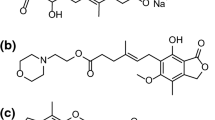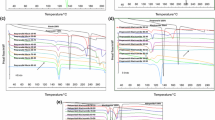Abstract
Aripiprazole (APZ) has poor physicochemical properties and bitter taste. The current study aimed to prepare salts of APZ with polycarboxylic acids (citric, malic, and tartaric acids) to improve physicochemical properties and impart sour taste to the drug. The salts were prepared by solubilization-crystallization method, and characterized by electron microscopic, spectroscopic, diffractometry, and thermal methods. The salts were assessed for pH solubility, pH-stability, dissolution, and solid-state stability. Fourier transformed infrared, X-ray powder diffraction, and differential scanning calorimetry data indicated formation of new solid phases. APZ and the salts exhibited pH-dependent solubility. The pH solubility curve shape was inverted “V,” inverted “W,” and inverted “U” for APZ, APZ-Citrate, and APZ-Malate and APZ-Tartrate, respectively. Compared to APZ, the solubility of salts at pH 4, 5, and 6 was 3.6–7.1, 23.9–31.5, and 143.4–373.3 folds of APZ. Increase in solubility in water by citrate, malate, and tartrate salts was 5562.8, 21,284.7, and 22,846.7 folds of APZ. The salt formation also leads to an increase in rate and extent of dissolution. The dissolution extent was 3.5 ± 0.5, 71.3 ± 1.2, 80.1 ± 6.2, and 86.1 ± 1.1% for APZ, APZ-Citrate, APZ-Malate, and APZ-Tartrate, respectively. Liquid and solid-state stabilities of the salts were comparable to APZ. In conclusion, salts of APZ with polycarboxylic acids improved solubility, and dissolution, and impart sour taste, which may improve palatability of the drug.









Similar content being viewed by others
References
Abilify® label. Access on May 05, 2020. https://www.accessdata.fda.gov/drugsatfda_docs/label/2004/21436slr006_abilify_lbl.pdf.
Turkyilmaz A, Sucuoglu E. Aripiprazole formulations. European Patent EP2908858B1, 2017. Access on April 27, 2018.
Prashanthi P, Sravanthi CRashmi B, Kumar YS. Formulation and evaluation of taste-masked oral disintegrating tablets of aripiprazole. Int J Pharm Sci Nanotechnol. 2015;8:2723–34.
Braun DE, Gelbrich T, Kahlenberg V, Tessadri R, Wieser J, Griesser UJ. Conformational polymorphism in aripiprazole: preparation, stability, and structure of five modifications. J Pharm Sci. 2009;98(6):2010–26.
Łaszcz M, Witkowska A. Studies of phase transitions in the aripiprazole solid dosage form. J Pharm Biomed Anal. 2016;117:298–303. https://doi.org/10.1016/j.jpba.2015.09.004.
EMEA – Scientific discussion-Abilify, 2005. Access on May 05, 2020. http://www.ema.europa.eu/docs/en_GB/document_library/EPAR_Scientific_Discussion/human/000471/WC500020164.pdf.
Aakeroy CB, Fasulo ME, Desper J. Cocrystal or salt: does it really matter? Mol Pharm. 2007;4:317–22.
Aitipamula S, Banerjee R, Bansal AK, Biradha K, Cheney ML, Choudhury AR, et al. Polymorphs, salts, and cocrystals: what’s in a name? Cryst Growth Des. 2012;12(5):2147–52.
Rahman Z, Zidan AS, Khan MA. Risperidone solid dispersion for orally disintegrating tablet: its formulation design and non-destructive methods of evaluation. Int J Pharm. 2010;400(1–2):49–58.
Rahman Z, Zidan AS, Berendt RT, Khan MA. Tannate complexes of antihistaminic drug: sustained release and taste masking approaches. Int J Pharm. 2012a;422(1–2):91–100.
Rahman Z, Zidan AS, Khan SR, Reddy IK, Khan MA. Chlorpheniramine tannate complexes: physicochemical, chemometric, and taste masking evaluation. Int J Pharm. 2012b;436(1–2):582–92.
Rachid O, Simons FER, Rawas-Qalaji M, Simons KJ. An electronic tongue: evaluation of the masking efficacy of sweetening and/or flavoring agents on the bitter taste of epinephrine. AAPS PharmSciTech. 2010;11:550–7.
Mishra R, Amin A. Formulation and characterization of rapidly dissolving films of cetirizine hydrochloride using pullulan as a film-forming agent. Indian J Pharm Educ Res. 2011;45:71–7.
Sugiura T, Uchida S, Namiki N. Taste-masking effect of physical and organoleptic methods on peppermint-scented orally disintegrating tablet of famotidine based on suspension spray-coating method. Chem Pharm Bull (Tokyo). 2012;60:315–9.
Cantor SL, Khan MA, Gupta A. Development and optimization of taste-masked orally disintegrating tablets (ODTs) of clindamycin hydrochloride. Drug Dev Ind Pharm. 2015;41(7):1156–64.
Cerea M, Zheng W, Young CR, McGinity JW. A novel powder coating process for attaining taste masking and moisture protective films applied to tablets. Int J Pharm. 2004;279:127–39.
Pearnchob N, Siepmann J, Bodmeier R. Pharmaceutical applications of shellac: moisture-protective and taste-masking coatings and extended-release matrix tablets. Drug Dev Ind Pharm. 2003;29:925–38.
Ishikawa T, Watanabe Y, Utoguchi N, Matsumoto M. Preparation and evaluation of tablets rapidly disintegrating in saliva containing bitter-taste-masked granules by the compression method. Chem Pharm Bull (Tokyo). 1999;47:1451–4.
Al-Omran MF, Al-Suwayeh SA, El-Helw AM, Saleh SI. Taste masking of diclofenac sodium using microencapsulation. J Microencapsul. 2002;19:45–52.
Shah PP, Mashru RC. Formulation and evaluation of primaquine phosphate taste-masked rapidly disintegrating tablet. J Pharm Pharmacol. 2008;60:1279–85.
Kumar K, Jena A, Ruckmani K, Rajendran P. Formulation and evaluation of taste masked orally disintegrating hydrochloride tablet. Int J Res Pharm Sci. 2010;1(3):328–32.
Taylor EPA. Tasteless derivative of chloramphenicol. J Pharm Pharmacol. 1953;5:254–6.
Hussain MA, Aungst BJ, Koval CA, Shefter E. Improved buccal delivery of opioid analgesics and antagonists with bitterless prodrugs. Pharm Res. 1988;5:615–8.
Breslin PA, Gingrich TN, Green BG. Ibuprofen as a chemesthetic stimulus: evidence of a novel mechanism of throat irritation. Chem Senses. 2001;26:55–65.
Shet N, Vaidya I. Taste masking: a pathfinder for bitter drugs. Int J Pharm Sci Rev Res. 2013;18:1–12.
Rahman Z, Zidan AS, Samy R, Sayeed VA, Khan MA. Improvement of physicochemical properties of an antiepileptic drug by salt engineering. AAPS PharmSciTech. 2012c;13(3):793–801.
Rahman Z, Siddiqui A, Khan MA. Orally disintegrating tablet of novel salt of antiepileptic drug: formulation strategy and evaluation. Eur J Pharm Biopharm. 2013;85(3 Pt B):1300–9.
Barakh Ali SF, Dharani S, Afrooz H, Khan MA, Mohamed EM, Kohli K, et al. Application of salt engineering to reduce/mask bitter taste of clindamycin. Drug Dev Ind Pharm. 2019;45(12):1871–8.
Liem DG, Mennella JA. Heightened sour preferences during childhood. Chem Senses. 2003;28(2):173–80.
Basalious EB, Abdullah A, Ibrahim M. Utility of mannitol and citric acid for enhancing the solubilizing and taste masking properties of β-cyclodextrin: development of fast-dissolving tablets containing extremely bitter drug. J Pharm Innov. 2014;9:309–20.
Sohi H, Sultana Y, Khar RK. Taste masking technologies in oral pharmaceuticals: recent developments and approaches. Drug Dev Ind Pharm. 2004;30(5):429–48.
Yoshida M, Haraguchi T, Uchida T. Bitterness evaluation of acidic pharmaceutical substances (NSAIDs) using a taste sensor. Chem Pharm Bull (Tokyo). 2014;62(12):1252–8.
Lugaz O, Pillias AM, Boireau-Ducept N, Faurion A. Time-intensity evaluation of acid taste in subjects with saliva high flow and low flow rates for acids of various chemical properties. Chem Senses. 2005;30(1):89–103.
FDA guidance for industry – regulatory classification of pharmaceutical co-crystals, 2018.
Dharani S, Rahman Z, Barakh Ali SF, Afrooz H, Khan MA. Quantitative estimation of phenytoin sodium disproportionation in the formulations using vibration spectroscopies and multivariate methodologies. Int J Pharm. 2018;539:65–74.
Barakh Ali SF, Rahman Z, Dharani S, Afrooz H, Khan MA. Chemometric models for quantification of carbamazepine anhydrous and dihydrate forms in the formulation. J Pharm Sci. 2019;108(3):1211–9.
ICH harmonized tripartite guideline- validation of analytical procedures: Text and methodology Q2(R1), 2005.
Piazzini V, Landucci E, Urru M, Chiarugi A, Pellegrini-Giampietro DE, Bilia AR, et al. Enhanced dissolution, permeation and oral bioavailability of aripiprazole mixed micelles: In vitro and in vivo evaluation. Int J Pharm. 2020;583:119361.
Mihajlovic T, Kachrimanis K, Graovac A, Djuric Z, Ibric S. Improvement of aripiprazole solubility by complexation with (2-hydroxy)propyl-β-cyclodextrin using spray drying technique. AAPS PharmSciTech. 2012;13(2):623–31.
Lin HL, Hsu PC, Lin SY. Theophyllineecitric acid co-crystals easily induced by DSC-FTIR microspectroscopy or different storage conditions. Asian J Pharm Sci. 2013;8:19–27.
Baran’ska H, Kuduk-Jaworska J, Szostak R, Romaniewska A. Vibrational spectra of racemic and enantiomeric malic acids. J Raman Spectrosc. 2003;34:68–76.
Brela MZ, Kubisiak P, Eilmes A. Understanding the structure of the hydrogen bond network and its influence on vibrational spectra in a prototypical aprotic ionic liquid. J Phys Chem B. 2018;122(41):9527–37.
Mandell DJ, Chorny I, Groban ES, Wong SE, Levine E, Rapp CS, et al. Strengths of hydrogen bonds involving phosphorylated amino acid side chains. J Am Chem Soc. 2007;129(4):820–7.
Sutton CCR, da Silva G, Franks GV. Modeling the IR spectra of aqueous metal carboxylate complexes: correlation between bonding geometry and stretching mode wavenumber shifts. Chem Eur J. 2015;21:6801–5.
Lu Y, Miller JD. Carboxyl stretching vibrations of spontaneously adsorbed and lb-transferred calcium carboxylates as determined by FTIR internal reflection spectroscopy. J Colloid Interface Sci. 2002;256:41–52.
Friedman RA. The dehydration of pharmaceutical hydrates under mechanical load. PhD (Doctor of Philosophy) thesis, University of Iowa, 2014. https://doi.org/10.17077/etd.ibgiy37q
Lu X, Tang J, Dang X, Jing X, Xu K, Li H, et al. Chiral recognition and determination of enantiomeric excess of chiral compounds by UV-visible-shortwave near infrared diffuse reflectance spectroscopy with chemometrics. RSC Adv. 2017;7:13552–60.
Chadha R, Saini A, Arora P, Chanda S, Jain DS. Cocrystals of efavirenz with selected coformers: preparation and characterization. Int J Pharm Pharm Sci. 2012;4:244–50.
Brittain HG. Malic acid in edited by Brittain HG. Analytical profiles of drug substances and excipients 2001;28: 153–195.
Sevukarajan M, Sodanapalli R, Thanuja B, Nair R. Preparation and pharmaceutical characterization of supra molecular complex of isoniazid with L(+) tartaric acid. J Biomed Sci Res. 2011;3(2):397–402.
Paulekuhn GS, Dressman JB, Saal C. Trends in active pharmaceutical ingredient salt selection based on analysis of the orange book database. J Med Chem. 2007;50(26):6665–72.
Stoimenovski J, MacFarlane DR, Bica K, Rogers RD. Crystalline vs. ionic liquid salt forms of active pharmaceutical ingredients: a position paper. Pharm Res. 2010;27(4):521–6.
Galcera J, Molins E. Effect of the counterion on the solubility of isostructural pharmaceutical lamotrigine salts. Cryst Growth Des. 2009;9:327–34.
Zidan AS, Rahman Z, Sayeed V, Raw A, Yu L, Khan MA. Crystallinity evaluation of tacrolimus solid dispersions by chemometric analysis. Int J Pharm. 2012;423(2):341–50.
Rahman Z, Siddiqui A, Bykadi S, Khan MA. Determination of tacrolimus crystalline fraction in the commercial immediate release amorphous solid dispersion products by a standardized X-ray powder diffraction method with chemometrics. Int J Pharm. 2014;475(1–2):462–70.
Bhattachrjee R, Jain YS, Bist HD. Laser Raman and infrared spectra of tartaric acid crystals. J Raman Spectrosc. 1989;20:91–7.
Author information
Authors and Affiliations
Corresponding author
Additional information
Publisher’s Note
Springer Nature remains neutral with regard to jurisdictional claims in published maps and institutional affiliations.
Rights and permissions
About this article
Cite this article
Afrooz, H., Mohamed, E.M., Barakh Ali, S.F. et al. Salt Engineering of Aripiprazole with Polycarboxylic Acids to Improve Physicochemical Properties. AAPS PharmSciTech 22, 31 (2021). https://doi.org/10.1208/s12249-020-01875-x
Received:
Accepted:
Published:
DOI: https://doi.org/10.1208/s12249-020-01875-x




